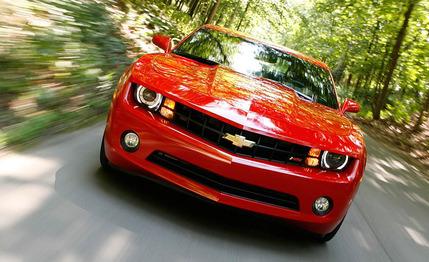 Short Take Road Test
Short Take Road Test
Click here to read our test of the V-8 Camaro.
Click here for full test numbers on all Camaro powertrains.
Attention, IROC-Z enthusiasts: the 2010 Chevrolet Camaro will not be available with your beloved T-top. If this is hugely disappointing, well, it may finally be time to put on a shirt with a collar, sell your Skynyrd CDs, and scissor the mullet.
In reviving the Camaro, Chevy is doing all it can to make the born-again car remind everyone of the sharp, cleanly styled 1967 original, rather than the more awkward later versions that seemed like accessories to tank-top wear and excesses in facial hair. This writer, the semi-proud owner of a 1995 Z28, knows intimately all the social assumptions that go with late-model Camaro ownership.
The Wait is Over
GM has of course been milking the revival for as many stories as it can get from us, hence the myriad press releases trumpeting everything from fuel economy to pricing, and the offer last fall to pilot a V-6powered Camaro prototype. Now, however, comes the payoff: tests of production cars, and even this base Camaro is deserving of more enlightened consideration, while still being powerful and capable enough to rock your face.
The V-6 features direct injection and dual overhead cams, the rear suspension is an independent multilink, and both available transmissions (an Aisin manual and a GM automatic) are six-speeds. Lest you think this setup is the sort of wine-and-cheese import-sedan formula that will make the Camaro a card-carrying metrosexual, the V-6 makes no fewer than 304 horsepower and blasts from 0 to 60 mph in a healthy 5.9 seconds when backed by a manual, and the quarter-mile breezes by in 14.5 seconds at 99 mph.
Even if those numbers don't seem mind-blowing, consider that the 3807-pound V-6 Camaro easily outdrags the V-6 versions of the Ford Mustang and Dodge Challenger. It will, of course, eat the dust of the lighter Ford Mustang Bullitt, a V-8, and the more powerful Dodge Challenger SRT8, both of which cover the quarter-mile nearly a second quicker. (The V-8powered Camaro is a different story.)
A Surprising Sports Car
Though the V-6 Camaro lacks the cojones to run with the biggest boys, it does make a compelling case as a decent sports car. It shows remarkable poise, with the suspension handling the pockmarked roads with hardly any disturbance to the cabin. The chassis is less jumpy than that of the Mustang but far more communicative than in the Challenger, and although the Camaro is nearly as wide as the Dodge it doesnt feel quite as big.
We drove two different wheel-and-tire combinations: 18-inch wheels with BF Goodrich Traction T/As on an automatic-transmission car and 19-inch Pirelli PZero Neros with the manual; either choice has a section width of 245. Twenty-inch wheels and tires are available with the RS package. The 18-inch tires are preferable, offering more steering feel and more predictable handling. On either set of tires, though, the Camaro turns in easily before setting into minor understeer that is easily cured with a stomp on the throttle. The engine responds willingly, although the high-pitched tone of the exhaust note feels out of placeour inner car lover appreciates the racy smoothness but our inner Camaro owner longs for the deep rumble of a V-8.
The Camaro also comes with two flavors of 6.2-liter V-8 producing 400 and 426 horsepower, but at a price premium. The V-6 is then the relative bargain of the lineup at $22,995, but the high-tech engine, the suspension, and even the transmissions arent cheap. This V-6 is the optional powerplant offered in the Cadillac CTS (2009 base price, $37,855) and the suspension shares a lot with the Pontiac G8 (entry point: $27,995). V-6 versions of the Ford Mustang and Dodge Challenger start in the $21,000 to $22,000 range, and the turbo-four version of the Hyundai Genesis Coupe starts at $22,750. The Camaro V-6 does undercut the Challenger R/T and Mustang GT, but those cars come with the ego-boosting power of two extra cylinders.
The Camaro outclasses its competitors on a few fronts, though. (Did you think it would one day be possible to see Camaro and outclass in the same sentence?) The ride quality of the Camaro doesnt even rate a comparison with the lesser Mustang, and it makes the Challengers handling feel plodding.
Good Show, GM, Good Show
Chevy is casting the new Camaro as a modernist sports coupe rather than a revisionist pony car, and its case holds some water. That argument is backed up with an EPA highway fuel-economy rating of 29 mpg, which is 6 mpg higher than the similarly powerful Mustang GT, and 3 mpg higher than the ratings for the Infiniti G37 and BMW 335i.
Where the entry-level Camaro has been placedbelow the V-8s but above lesser-powered V-6smight seem like a confusing market position, but its true to the Camaros social heritage. Like the mullet that is often associated with it, it looks like the V-6 Camaro will walk a fine line between classiness and savagery.